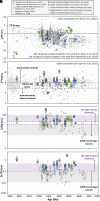Zircon geochemistry from early evolved terranes records coeval stagnant- and mobile-lid tectonic regimes
- PMID: 39284064
- PMCID: PMC11441487
- DOI: 10.1073/pnas.2405378121
Zircon geochemistry from early evolved terranes records coeval stagnant- and mobile-lid tectonic regimes
Abstract
Determining the mechanisms by which the earliest continental crust was generated and reworked is important for constraining the evolution of Earth's geodynamic, surface, and atmospheric conditions. However, the details of early plate tectonic settings often remain obscured by the intervening ~4 Ga of crustal recycling. Covariations of U, Nb, Sc, and Yb in zircon have been shown to faithfully reflect Phanerozoic whole-rock-based plate-tectonic discriminators and are therefore useful in distinguishing zircons crystallized in ridge, plume, and arc-like environments, both in the present and in deep time. However, application of these proxies to deciphering tectonic settings on the early Earth has thus far been limited to select portions of the detrital zircon record. Here, we present in situ trace-element and oxygen isotope compositions for magmatic zircons from crystalline crustal rocks of the Acasta Gneiss Complex and the Saglek-Hebron Complex, Canada. Integrated with information from whole-rock geochemistry and zircon U-Pb, Hf, and O isotopes, our zircon U-Nb-Sc-Yb results reveal that melting of hydrated basalt was not restricted to a single tectonomagmatic process during the Archean but was operative during the reworking of Hadean protocrust and the generation of juvenile crust within two cratons, as early as 3.9 Ga. We observe zircon trace-element compositions indicative of hydrous melting in settings that otherwise host seemingly differing whole-rock geochemistry, zircon Hf, and zircon O isotopes, suggesting contemporaneous operation of stagnant-lid (oceanic plateau) and mobile-lid (arc-like) regimes in the early Archean.
Keywords: Archean; crustal evolution; isotope geochemistry; zircon.
Conflict of interest statement
Competing interests statement:The authors declare no competing interest.
Figures




References
-
- Wilde S. A., Valley J. W., Peck W. H., Graham C. M., Evidence from detrital zircons for the existence of continental crust and oceans on the Earth 4.4 Gyr ago. Nature 409, 175–178 (2001). - PubMed
-
- Valley J. W., Peck W. H., King E. M., Wilde S. A., A cool early Earth. Geology 30, 351–354 (2002).
-
- Harrison T. M., Hadean Earth (Springer, 2020).
-
- Shirey S. B., Richardson S. H., Start of the Wilson cycle at 3 Ga shown by diamonds from subcontinental mantle. Science 333, 434–436 (2011). - PubMed
-
- Moyen J.-F., Martin H., Forty years of TTG research. Lithos 148, 312–336 (2012).
Grants and funding
LinkOut - more resources
Full Text Sources
Research Materials
Miscellaneous

